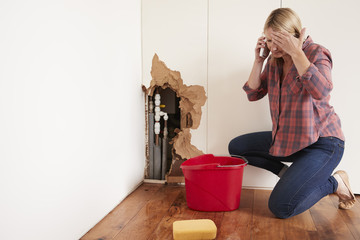
Real Estate is an asset class that delivers stable income streams and capital gains. It also provides tax benefits and has a low-to-negative correlation with other major asset classes.
Real estate consists of land and its permanent attachments, including natural resources such as growing crops, minerals, or water. It excludes personal property such as appliances and mineral rights under the land. Check out https://scamrisk.com/ for more information.
Definition
For millions of people, real estate in the form of their homes is their largest investment and the single most valuable asset they will ever own. The real estate industry is a vital component of any nation’s economy. It provides employment in fields like home improvement, development, construction, lending, insurance and brokerage. The real estate market is a leading indicator of the economy and can dramatically impact individual families’ financial well-being.
Technically, real estate is land plus anything that is fixed, immovable and permanently attached to the property like buildings, roads and utility systems. Land with any of these structures is referred to as improved, while land without them is referred to as unimproved. This can be a residential property, such as a house or condo; commercial property, such as offices, malls and warehouses; or industrial property.
Real estate is also a type of personal property, but it’s different from the typical car or jewelry that many people own. Real estate is an asset that can be inherited or passed down from generation to generation, and it has the ability to appreciate in value over time. For this reason, it’s often seen as a great way to diversify a person’s portfolio and to take advantage of certain tax laws.
There are several types of real estate, including commercial, industrial and raw land. Residential real estate refers to any property that’s primarily intended for human habitation, such as houses and condos. Commercial real estate has a business use and focus, and it can be owner-occupied or leased out to businesses. Industrial real estate is a subset of commercial real estate and encompasses property used for manufacturing, warehousing or other business-related activities.
Types
Real estate is divided into several different categories, based on what it can be used for. The main categories are residential, commercial and industrial. Residential real estate is land and buildings that are primarily zoned for housing. This category includes everything from single-family homes to multifamily dwellings like duplexes and quadruplexes. It also includes portable dwellings like houseboats.
The second general category is commercial, which encompasses properties that are primarily used for business purposes. This category can include retail spaces such as malls and individual stores, offices and apartment buildings that generate income for their owners. It can also include warehouses that store and distribute products.
Finally, there is industrial property, which covers buildings and land used for manufacturing purposes. This can include factories, workshops and even large warehouses that serve as distribution centers.
Real estate investments can be made as either buy-and-hold assets or active management assets. The former includes long term rents and vacation rentals while the latter involves acquiring properties and adding value to them in order to sell them at a higher value. Many investors also engage in the practice of flipping, which is when they acquire a property and quickly renovate it in order to turn a profit.
While all types of real estate are affected by the local economy and zoning laws, the type of real estate that has the most potential is undeveloped or vacant land. Developers often purchase land and combine it with other property in order to increase its density and overall value. Vacant or undeveloped land that is in the path of future development is often considered prime real estate because of its high chance of increasing in value as more people move to the area.
Due Diligence
Whether the real estate is residential or commercial, due diligence is a critical part of any real estate transaction. This process involves thoroughly investigating a property and examining its financial stability, both before and after the sale. It is an important way to avoid costly and time-consuming issues that could arise after the purchase of a property.
This process may include speaking with local home insurance companies to find out what it would cost to insure the property, as well as determining if there are any liens or legal disputes involving the property. It also involves checking with city officials to see if the property meets zoning requirements for the type of use it is intended.
If a buyer discovers something during the due diligence period that is material, they can ask the seller to fix it or terminate the contract and receive a full refund of their earnest money deposit. This is why it is important to negotiate a reasonable due diligence period in the purchase contract.
In the case of commercial real estate, the due diligence process may be much more extensive. Depending on the scope of the transaction, it can involve an examination of the building’s structural integrity, a review of past renovations and a determination of the suitability of the space for the purchaser’s intended purpose. In some cases, raw land may require a more extensive evaluation by site engineers and planners to ensure that the future development complies with zoning requirements.
Performing due diligence is the only way to make sure that you are purchasing a property that will provide you with the expected returns on investment. Without this important step, you run the risk of making a bad investment that will ultimately be costly to you in both your time and money.
Scams
Real estate can be a lucrative business. However, as with any industry that involves large sums of money, fraudsters are likely to find ways to take advantage of unsuspecting victims. Whether you are a professional real estate investor or just starting out, it is important to know the common scams in real estate to avoid them.
One of the most prevalent real estate scams involves wire fraud. Criminals impersonate the buyer or seller and request that the funds be sent to an illegitimate account. They do this by hacking into the buyer or seller’s email and sending phishing emails to other parties involved in the transaction, such as the title company or the lawyer. These emails contain information that reroutes the payment to the fraudster’s account.
Another common real estate scam involves bogus rental properties. Criminals will post a property listing that doesn’t exist and then collect security deposits and other fees from unsuspecting victims. They may even rent the property out to a tenant without ever owning it. The criminals then disappear with the money and the victim is left out of pocket.
Local real estate associations are warning their members about a new type of real estate scam that has been hitting the market. This latest trick involves fraudsters contacting real estate agents and posing as owners to list vacant lots and homes for sale. Once the property is listed, it can be sold before the real estate owner knows about it and the scammers can make off with thousands of dollars.
Lastly, scammers can use fake photos and videos to trick would-be buyers into believing that they are viewing a property in person. A savvy buyer or seller will always ask for proof of identity before agreeing to any transactions and never send any money to an unknown account. They should also insist on seeing the property in person before sending any funds, especially if they are asked to pay a deposit.
Marketing
There are many different ways to market in the real estate industry, and it’s important to find the right mix for your business. Some brokers and agents focus on digital marketing strategies, while others use traditional methods like postcards and direct mail. Whatever your goals, it’s essential to identify them and set measurable milestones. This will help you determine how well your strategy is working and if it needs to be tweaked.
Using email campaigns is another effective way to nurture leads and maintain relationships with existing clients. Personalized outreach messages can be used to share advice, important announcements (like open house dates) and branded content that’s relevant to your audience. Additionally, email marketing can be used to drive traffic to your website and attract potential buyers or tenants.
Real estate content marketing involves creating and distributing valuable, relevant, and informative blog posts, articles, and infographics to establish your expertise and attract organic traffic. This is an excellent way to showcase your unique selling points and build trust with potential buyers or tenants. Additionally, real estate agents can also host webinars to educate their audiences about specific markets or types of properties.
Commercial real estate agents can also leverage performance-based advertising campaigns on social media platforms like LinkedIn and Facebook. These Ads are highly-targeted and allow you to select who, when, and where your message is displayed. For example, if you’re selling or leasing life science properties in a certain geographic area, you can target C-level executives in the bioscience industry with an Ad that’s shown on their desktop, mobile device, or in their LinkedIn news feed.
Many real estate businesses attend local and national events to network with other professionals, build relationships, and learn more about market trends. While these events can be a great source of lead generation, they can also be time-consuming and costly.



 Having a clean gutter is essential for the look of your home. If it is clogged, overflowing water can cause cracks in the foundation, and flooding of your basement. It also serves as a breeding ground for harmful bacteria, mold, and pests. The gutters need to be cleaned regularly to prevent these problems. A good time to do this is every spring and fall.
Having a clean gutter is essential for the look of your home. If it is clogged, overflowing water can cause cracks in the foundation, and flooding of your basement. It also serves as a breeding ground for harmful bacteria, mold, and pests. The gutters need to be cleaned regularly to prevent these problems. A good time to do this is every spring and fall.
 Cleaning up water damage is difficult and requires an expert’s assistance. The first step is to get the property inspected by an expert. Make sure the inspector makes a note of the water damage. Next, get at least three or four estimates for the water damage repair. These estimates will be useful when negotiating with the seller. A CMA report should accompany water damage restoration so the buyer can better understand the property’s worth.
Cleaning up water damage is difficult and requires an expert’s assistance. The first step is to get the property inspected by an expert. Make sure the inspector makes a note of the water damage. Next, get at least three or four estimates for the water damage repair. These estimates will be useful when negotiating with the seller. A CMA report should accompany water damage restoration so the buyer can better understand the property’s worth.